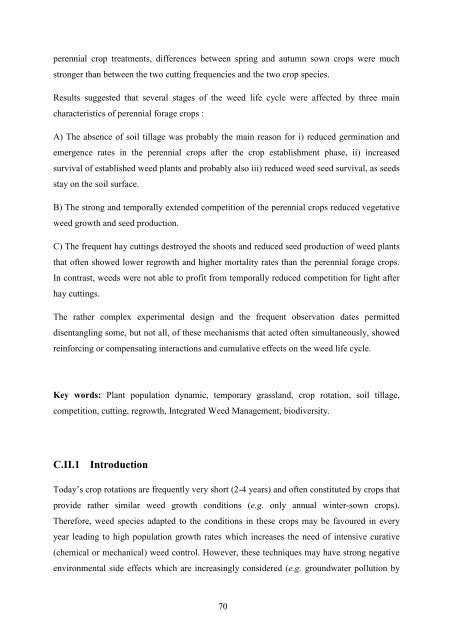Diversifying crop rotations with temporary grasslands - Université de ...
Diversifying crop rotations with temporary grasslands - Université de ...
Diversifying crop rotations with temporary grasslands - Université de ...
Create successful ePaper yourself
Turn your PDF publications into a flip-book with our unique Google optimized e-Paper software.
perennial <strong>crop</strong> treatments, differences between spring and autumn sown <strong>crop</strong>s were much<br />
stronger than between the two cutting frequencies and the two <strong>crop</strong> species.<br />
Results suggested that several stages of the weed life cycle were affected by three main<br />
characteristics of perennial forage <strong>crop</strong>s :<br />
A) The absence of soil tillage was probably the main reason for i) reduced germination and<br />
emergence rates in the perennial <strong>crop</strong>s after the <strong>crop</strong> establishment phase, ii) increased<br />
survival of established weed plants and probably also iii) reduced weed seed survival, as seeds<br />
stay on the soil surface.<br />
B) The strong and temporally exten<strong>de</strong>d competition of the perennial <strong>crop</strong>s reduced vegetative<br />
weed growth and seed production.<br />
C) The frequent hay cuttings <strong>de</strong>stroyed the shoots and reduced seed production of weed plants<br />
that often showed lower regrowth and higher mortality rates than the perennial forage <strong>crop</strong>s.<br />
In contrast, weeds were not able to profit from temporally reduced competition for light after<br />
hay cuttings.<br />
The rather complex experimental <strong>de</strong>sign and the frequent observation dates permitted<br />
disentangling some, but not all, of these mechanisms that acted often simultaneously, showed<br />
reinforcing or compensating interactions and cumulative effects on the weed life cycle.<br />
Key words: Plant population dynamic, <strong>temporary</strong> grassland, <strong>crop</strong> rotation, soil tillage,<br />
competition, cutting, regrowth, Integrated Weed Management, biodiversity.<br />
C.II.1 Introduction<br />
Today’s <strong>crop</strong> <strong>rotations</strong> are frequently very short (2-4 years) and often constituted by <strong>crop</strong>s that<br />
provi<strong>de</strong> rather similar weed growth conditions (e.g. only annual winter-sown <strong>crop</strong>s).<br />
Therefore, weed species adapted to the conditions in these <strong>crop</strong>s may be favoured in every<br />
year leading to high population growth rates which increases the need of intensive curative<br />
(chemical or mechanical) weed control. However, these techniques may have strong negative<br />
environmental si<strong>de</strong> effects which are increasingly consi<strong>de</strong>red (e.g. groundwater pollution by<br />
70

















